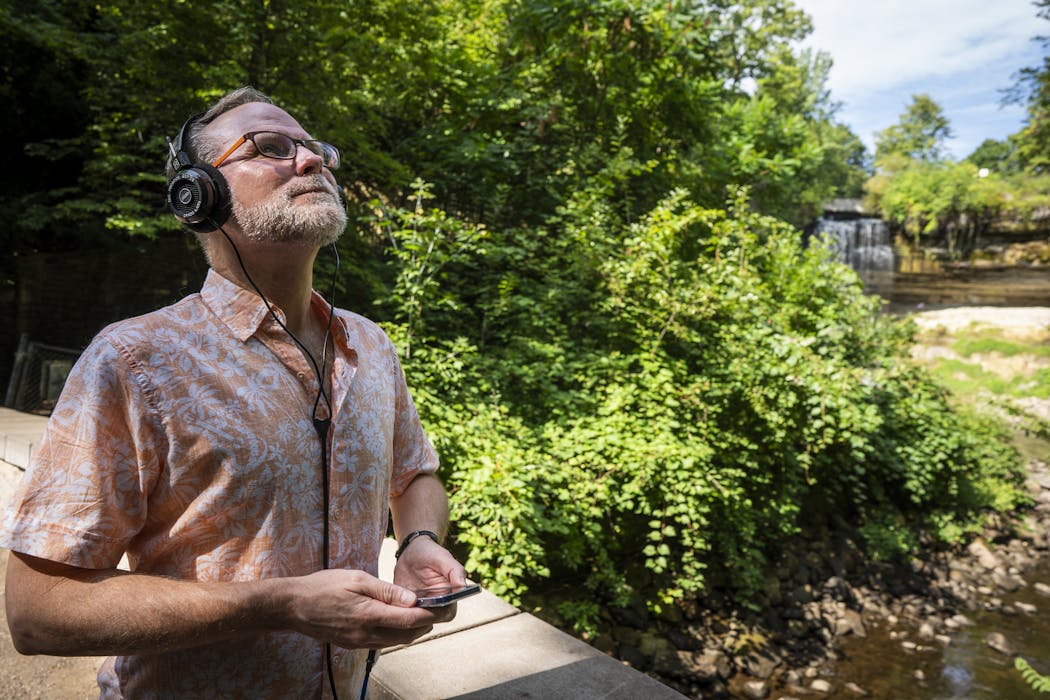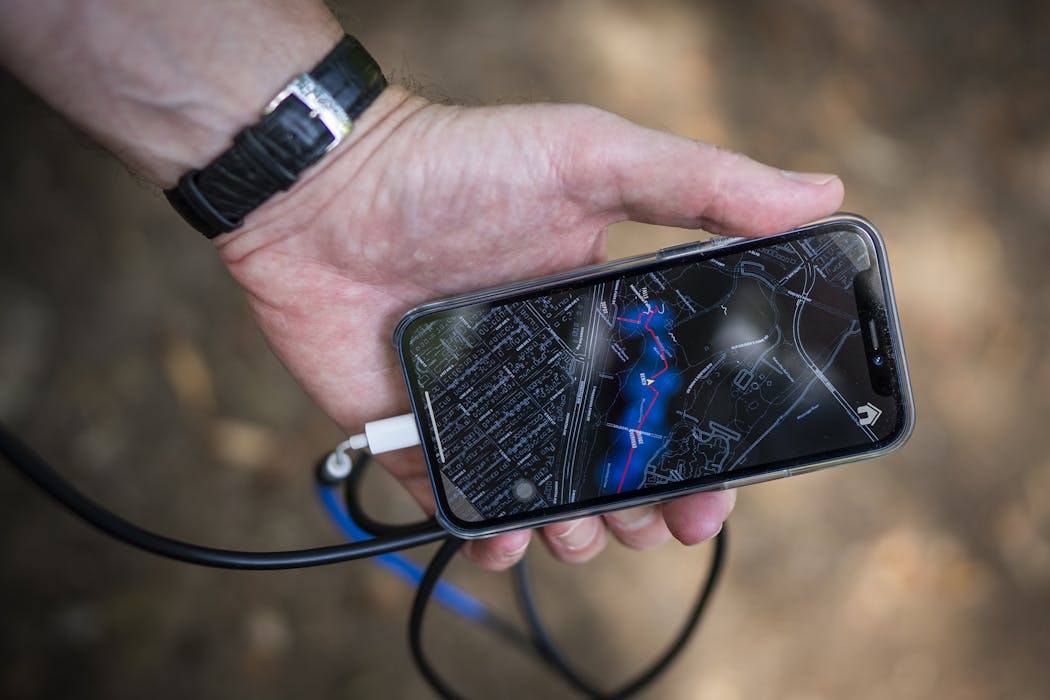The sound enters your ears as you approach the trellis at the top of the bluff: a soft periodic plunk like pizzicato strings. The plunks grow more frequent as you follow the path toward the edge of Minneapolis' Minnehaha Falls, where a meandering creek that began at Lake Minnetonka plunges into a valley. Your steps are guided by an arrow on your phone's display screen.
You are on a "soundwalk," listening to music created expressly to accompany your surroundings. In this case, composer Scott L. Miller has created this soundtrack for your trek down Minnehaha Creek toward its terminus at the Mississippi River. The music changes as you get farther down the path, moods morphing as you cross bridges and pass landmarks.
This sonic journey comes courtesy of "SonAR II," Miller's mobile phone app that uses global positioning software to tailor sounds to your surroundings. What comes through your headphones or earbuds depends upon where you are in the park.
"SonAR" stands for "sonic augmented reality," and the app is available through the Apple App Store and Google Play. It allows you to experience an approximately 45-minute stroll down the creek and back, the sounds of nature interweaving with an electronic soundscape composed and recorded by Miller.
This is "SonAR II" because Miller created his first "soundwalk" at St. Cloud State University, where he's a music professor.
"I was working with the Visualization and Simulation Lab at St. Cloud State on virtual reality projects," Miller said from his home in Otsego, Minn. "They also introduced me to augmented reality. And one of the first things that came up was having GPS tracking so you could have these virtual 'speakers' located anywhere in the world, and, as you get close to those speakers, you can hear them. I started experimenting with those."
When Miller received the Hellervik Prize from St. Cloud State — an award designed for faculty members to pursue interesting projects — he knew that he wanted to use the funding to create a soundwalk. While he dreamed of more exotic locales, COVID-19 placed constraints upon travel. It was his daughter who suggested Minnehaha Park.
"I said, 'OK,' and went down and did a soundwalk — a listening walk, really — where I took notes and just listened and recorded the sound of that trail and some other parts of the park," Miller said. "And then I spent time listening and thinking about what I was hearing, what kinds of sounds really dominated the recordings and created what in acoustic ecology would be called a 'keynote,' a sound that is often equated with the tonality of a given acoustic environment. In the park, it's really water more than anything else.
"But that water really changes. After the falls, as you follow the creek, the sound of water continues to dominate, but it's constantly being transformed."
Miller recommends that noise-cancelling headphones not be used, for the sound of water, wind and birdsong — and perhaps planes, train horns and conversations of fellow pedestrians — should be allowed to become part of your listening experience.
"A lot of what I'm interested in, in both music and visual art, are contrasts, clean lines meeting messy ones," Miller said. "There are a lot of things about this that challenge or surprise folks. When you tell them there will be music, I suspect some folks won't know precisely what's coming their way."
So let it be said that you won't hear something like Beethoven's "Pastoral" Symphony, a work similarly inspired by nature hikes. Miller's musical style is closer to what's customarily called "ambient," unspooling slowly as sounds are subtly layered atop one another.
For example, those periodic plunks that emerge near the start of your walk grow closer together as you descend a series of staircases down to the base of the falls.
"Those pizzicato-like sounds I thought of as drops that coalesce and create a creek, a waterfall," Miller said.
As for the precipitous descent, "I've struggled with the accessibility," Miller said. "It's not 100 percent accessible, and that's been a concern of mine." It is possible to reach the valley in a stairless descent toward the eastern part of the park and pick up the soundwalk there, but even that is somewhat steep.
The base of the falls is one of the most crowded areas in the park. Indeed, a marriage proposal was in progress when I first took this aurally enhanced journey, complete with flower-petal-festooned carpet and chilled Champagne. But foot traffic thins as you venture onward.
While the composer hesitates to call them "movements," there are distinctly different soundscapes, depending upon where you're walking in the park. When they transition, Miller said that you can sometimes take a step in one direction or another and create a fascinating mashup, never more so than when walking under the bridge that leads to the Minnesota Veterans Home.
Soon after that, you reach the creek's mouth at the Mississippi, then can reverse course and notice how the mood and energy of the music changes according to your coordinates. As you return to your starting point, the music may stay in your head even after you remove your headphones.
"We collect a lot of information by listening to our environment," Miller said. "And that's one of the things I was really trying to tap into with this app. If we remember to actively listen, that can completely change our experience with an environment."
Rob Hubbard is a freelance classical music critic. • wordhub@yahoo.com
SonAR II app
Available: At the Apple App Store and Google Play.
Information: ScottLMiller.net.

GOP endorses Tad Jude for congressional seat Dean Phillips is leaving
One day in the frantic life of a Children's Minnesota emergency room nurse
Sen. Nicole Mitchell off committee assignments while case under review



